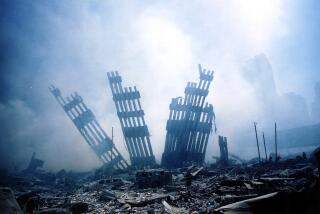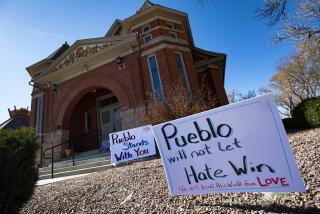Some Plotters May Have Gone West
- Share via
RIYADH, Saudi Arabia — Days before the suicide car bombings here that killed at least 34 people last week, members of an Al Qaeda cell slipped out of the country and headed for Europe or America, a senior Saudi official said Monday, adding that there is a “very serious” threat of another terrorist strike.
Indications that terrorists may be on the move came as U.S. and Saudi officials said cooperation between their two nations to track down Al Qaeda operatives is significantly improving. But the prospects of more attacks was another sign that Osama bin Laden’s network -- although weakened by recent arrests and raids -- remains a potent danger across the globe.
“My gut feeling is that something big will happen either in Saudi Arabia or America,” said Prince Bandar ibn Sultan, the Saudi ambassador to Washington, adding that intelligence agencies are detecting “a high level of chatter both regionally and in international spots” from terrorist networks. The ambassador said he didn’t know if this indicated a resurgence of Al Qaeda or an activation of cells that had gone underground after the Sept. 11 attacks on New York and the Pentagon.
The threat of terrorist attacks was underscored over the weekend when suicide bombings in Morocco killed 42.
At the White House on Monday, President Bush sought to reassure the public, saying, “We are slowly, but surely, dismantling the Al Qaeda network.” He acknowledged, however, that the recent attacks are a reminder of the difficulties of rooting out terrorist groups that melt into the population in cities such as Riyadh, the Saudi capital.
“We’re trying to chase down the people who hide and move around in dark corners of the world,” said Bush, adding that the U.S. is trying to determine whether Al Qaeda was responsible for the Moroccan attacks. “They plot and they plan, and they pop up and kill. They don’t care about innocent life.”
In an interview with journalists at his palace compound here, the ambassador said Saudi Arabia had a “hard core” of about 50 terrorist ringleaders who were supported by 300 militants and sympathizers. He said Saudi intelligence agencies have determined that three Al Qaeda cells had been operating in the kingdom. One of them orchestrated the May 12 car bombings, another went into hiding and a third left the country, most likely bound for the West.
“We don’t believe there are tens of thousands of Al Qaeda members” in Saudi Arabia, a U.S. official said.
The official said there is “really good cooperation” between Saudi and American intelligence agencies, including a team of more than 60 FBI, CIA and other U.S. investigators who arrived here in recent days. The characterization of cooperation follows months of frustration by some U.S. officials who said the kingdom was lax in its vigilance against militants, and by Saudi officials who complained that the U.S. was not sharing information.
“You will not find a complaint from the FBI,” said Bandar, “about what we are doing together about terrorists.”
Bandar showed off a 3-inch thick binder -- one of a number of items he said Saudi investigators turned over to their American counterparts. The binder contained passport copies and documents written by the 19 men believed to have carried out the three bombings that ripped through Westerners’ residential compounds in Riyadh. Some of the information, the ambassador said, was given to U.S. authorities months ago. The most recent details were discovered on May 6, when Saudi security agents had a gun battle with some of the suspects near a safe house kept by the cell.
Of the 19 suspects, nine are believed to have died in the attacks. The ambassador said three of the nine have been identified through DNA testing. Six more are expected to be verified in the same way. The other 10 militants remain at large. Saudi authorities have arrested four men accused of providing logistical support to the group. A scouring of the cell’s safe house, said Bandar, turned up “a bunch” of women’s wigs, make-up kits and 377 kilos of explosives.
Bandar noted that Saudi intelligence for months had picked up indications that an attack was being planned. The May 6 raid on the safe house, he said, most likely forced the group to accelerate its mission before authorities could apprehend the cell members. Some U.S. and Saudi officials suggest the attack had been planned months, if not a year earlier.
“Yes, we had the warnings,” he said. “But never a specific place
The Saudi government says it is also attempting to curb the religious fanaticism of its imams and clerics. Three radical Islamic leaders, according to Bandar, left Saudi Arabia days before the U.S. invasion of Iraq. The ambassador said they may have gone temporarily into northern Iraq to seek sanctuary with the Ansar al-Islam movement. Their whereabouts now are unknown.
The recent attacks, said Bandar, “will be recorded as the 9/11 for Saudi Arabia.... We are going through tough times.”
Meanwhile, Spanish officials announced that Spain’s best-known magistrate will lead that nation’s investigation of the Morocco bombings, which European police believe to be the work of Moroccan extremists with connections to Al Qaeda. Spanish and French police are in Morocco working with their local counterparts on the case.
Baltasar Garzon has spent years prosecuting Basque and Islamic terrorism and currently leads the investigation of a Madrid-based Al Qaeda cell accused of playing a support role in the Sept. 11 plot. He became known worldwide when he ordered the arrest in London of former dictator Gen. Augusto Pinochet of Chile for alleged human rights crimes.
Moroccan press reports Monday said six of the 14 suicide bombers had been identified and were 18 to 24 years in age.
The daily Al Ahdath al Maghribia said security services were interrogating at least two Egyptians and a Saudi in Casablanca and that the group that led the attacks had received orders from abroad.
Times staff writers Greg Miller in Washington and Sebastian Rotella in Paris and wire services contributed to this report.
More to Read
Sign up for Essential California
The most important California stories and recommendations in your inbox every morning.
You may occasionally receive promotional content from the Los Angeles Times.











